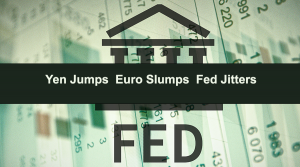Yen jumps, euro slumps, Fed jitters

The safe-haven yen and U.S. dollar rose on Tuesday while the risk-sensitive New Zealand dollar fell with the euro amid escalating worries about both a potential military conflict in Ukraine and a faster pace of Federal Reserve policy tightening.
The Australian dollar rose briefly after strong consumer price numbers boosted the case for a Reserve Bank interest rate increase this year, but then succumbed to the sell-off in riskier assets.
As the Fed begins a two-day policy meeting later in the global day, and investors will be anxious for any hints on the timing and pace of rate hikes, as well as about how fast the central bank will shrink its more-than $8 trillion holdings of Treasuries and mortgage debt.
The Fed will hand down its policy decision on Wednesday, which will be scrutinized for clues on a timetable for interest rate hikes and asset tapering. Money markets are priced for a first hike in March, with three more quarter-point increases by the end of 2022.
The case for the Fed potentially following up a March rate rise before the June meeting – even as early as April – is a very compelling one, and there is a risk that the market will still have to reprice,” said NAB’s Attrill.
“The geopolitical risk has just added a new layer of safe-haven support.”This geopolitical tension between the U.S. and Russia over Ukraine that Attrill is referring to continues to mount. NATO said it was putting forces on standby and reinforcing eastern Europe with more ships and fighter jets, a move denounced by Russia as an escalation of tensions.
Markets had largely ignored this tension until recently but are pricing more of a risk premium into the euro, according to ING Bank strategist Francesco Pesole. Concerns are also mounting that the tensions could prompt Moscow to cut energy supplies to Europe, he added..
ING Bank strategist Francesco Pesole said markets were pricing more of a risk premium into the euro, with fears increasing that Russia’s stand-off with the West over Ukraine could prompt Moscow to curb energy supplies to Europe.
The Aussie fared relatively better, retreating 0.19% to $0.7132. Earlier it leapt as much as 0.45% to $0.7178 after a key inflation gauge surged to a 7 1/2-year peak.
Many analysts contend that such a pace will force the RBA into a rate hike this year, despite Governor Philip Lowe previously maintaining that such an eventuality was extremely unlikely. The central bank meets on Feb. 1 to decide policy.
After the inflation data, TD Securities brought forward its forecast for a rise in the policy rate from a record low 0.1% to 0.25% to August, having previously expected a rise in the the fourth quarter of this year.
At next week’s meeting, “we expect the RBA’s central forecast will now shift to a hike in 2023, but the RBA will possibly open the door to a rate hike in 2022,” he wrote.
Meanwhile, cryptocurrencies traded weaker, but were well off the lows tested at the start of the week. Bitcoin changed hands at close to $36,000, after dipping below $33,000 on Monday for the first time in six months. It has halved in value since touching a record $69,000 in November.
Important Note: The information found on Ausprime platform is intended only to be informative, is not advice nor a recommendation, nor research, or a record of our trading prices, or an offer of, or solicitation for a transaction in any financial instrument and thus should not be treated as such. The information provided does not include any specific investment objectives, financial situation and needs of any specific person who may receive it. The past performance is not a reliable indicator of future performance and/or results. Past Performance or Forward-looking scenarios are not a guarantee of future performance. Actual results may differ materially from those anticipated in forward-looking or past performance statemen
